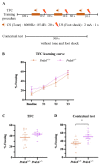Behavioral and Synaptic Phenotypes of Female Prdx6-/- Mice
- PMID: 35740098
- PMCID: PMC9219992
- DOI: 10.3390/antiox11061201
Behavioral and Synaptic Phenotypes of Female Prdx6-/- Mice
Abstract
Peroxiredoxin 6 (PRDX6) is expressed throughout the brain, including the hippocampus, where it plays a potential role in synaptic regulation and forming emotional and spatial memories. PRDX6 is predominantly detected in the female mouse's hippocampus; thus, we investigate the effect of the Prdx6 gene on behavioral phenotypes and synaptic functions using female Prdx6 knockout (Prdx6-/-) mice. Our results demonstrate that female Prdx6-/- mice exhibited anxiety-like behavior, enhanced contextual fear memory, and impaired spatial memory. We also found increased, paired-pulse facilitation ratios, and decreased long-term potentiation (LTP) in the hippocampal region of these female Prdx6-/- mice. The present study helps to understand better the PRDX6's role in emotional response and spatial memory formation in female mice.
Keywords: antioxidation; anxiety; long-term potentiation; peroxiredoxin 6; spatial memory.
Conflict of interest statement
The authors report no biomedical financial interests or potential conflicts of interest.
Figures







Similar articles
-
Lack of the peroxiredoxin 6 gene causes impaired spatial memory and abnormal synaptic plasticity.Mol Brain. 2021 Apr 19;14(1):72. doi: 10.1186/s13041-021-00779-6. Mol Brain. 2021. PMID: 33874992 Free PMC article.
-
Enhanced contextual fear memory in peroxiredoxin 6 knockout mice is associated with hyperactivation of MAPK signaling pathway.Mol Brain. 2021 Feb 25;14(1):42. doi: 10.1186/s13041-021-00754-1. Mol Brain. 2021. PMID: 33632301 Free PMC article.
-
Peroxiredoxin 6 Knockout Mice Demonstrate Anxiety Behavior and Attenuated Contextual Fear Memory after Receiving Acute Immobilization Stress.Antioxidants (Basel). 2021 Sep 4;10(9):1416. doi: 10.3390/antiox10091416. Antioxidants (Basel). 2021. PMID: 34573048 Free PMC article.
-
Aquaporin-4 water channels and synaptic plasticity in the hippocampus.Neurochem Int. 2013 Dec;63(7):702-11. doi: 10.1016/j.neuint.2013.05.003. Epub 2013 May 15. Neurochem Int. 2013. PMID: 23684954 Free PMC article. Review.
-
Stress generates emotional memories and retrograde amnesia by inducing an endogenous form of hippocampal LTP.Hippocampus. 2004;14(3):281-91. doi: 10.1002/hipo.10186. Hippocampus. 2004. PMID: 15132427 Review.
Cited by
-
Epigenome-Wide DNA Methylation in Unipolar Depression: Predictive Biomarker of Antidepressant Treatment Response?Int J Neuropsychopharmacol. 2024 Nov 1;27(11):pyae045. doi: 10.1093/ijnp/pyae045. Int J Neuropsychopharmacol. 2024. PMID: 39367879 Free PMC article.
References
-
- Chae H.Z., Oubrahim H., Park J.W., Rhee S.G., Chock P.B. Protein glutathionylation in the regulation of peroxiredoxins: A family of thiol-specific peroxidases that function as antioxidants, molecular chaperones, and signal modulators. Antioxid. Redox Signal. 2012;16:506–523. doi: 10.1089/ars.2011.4260. - DOI - PMC - PubMed
Grants and funding
LinkOut - more resources
Full Text Sources
Miscellaneous

